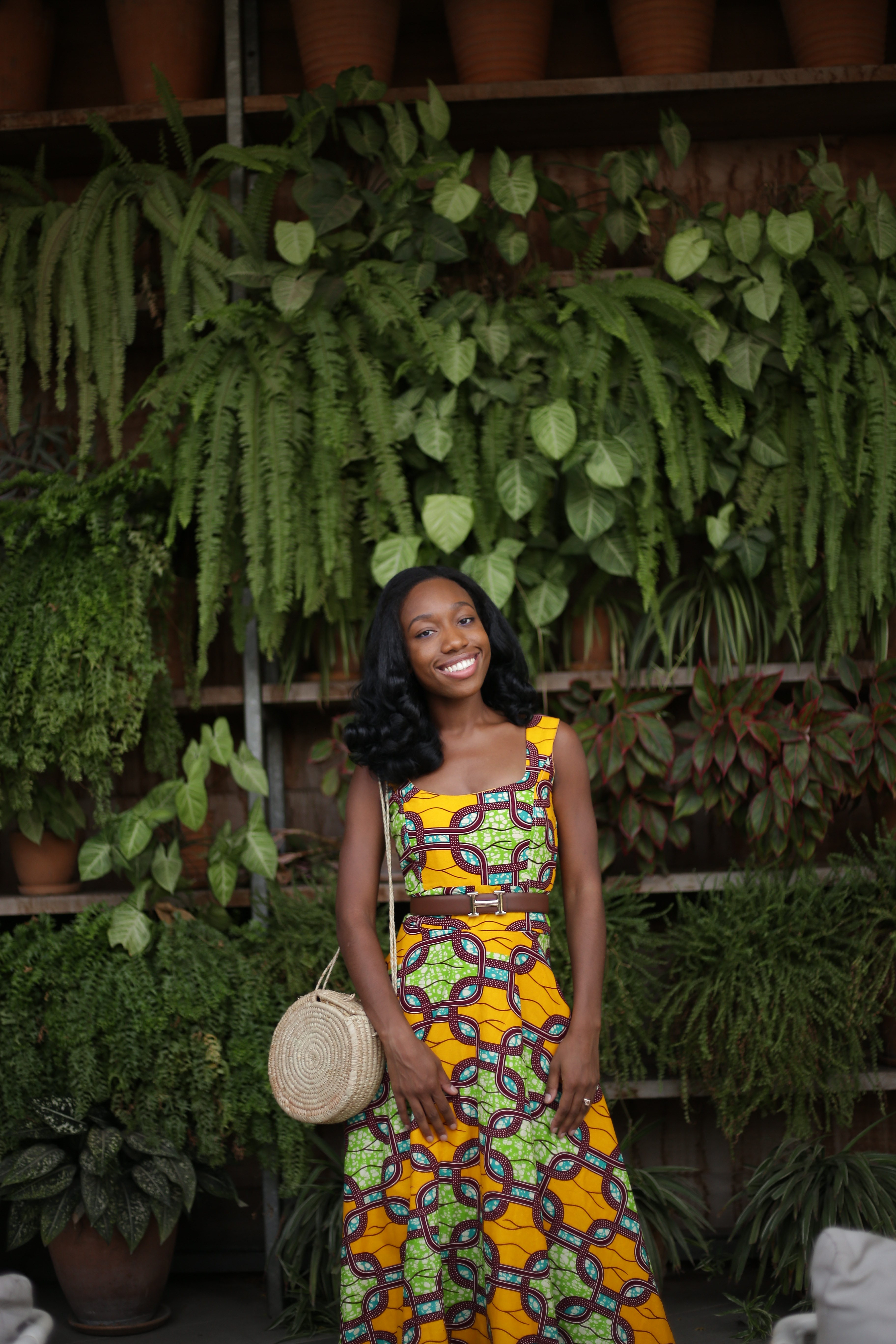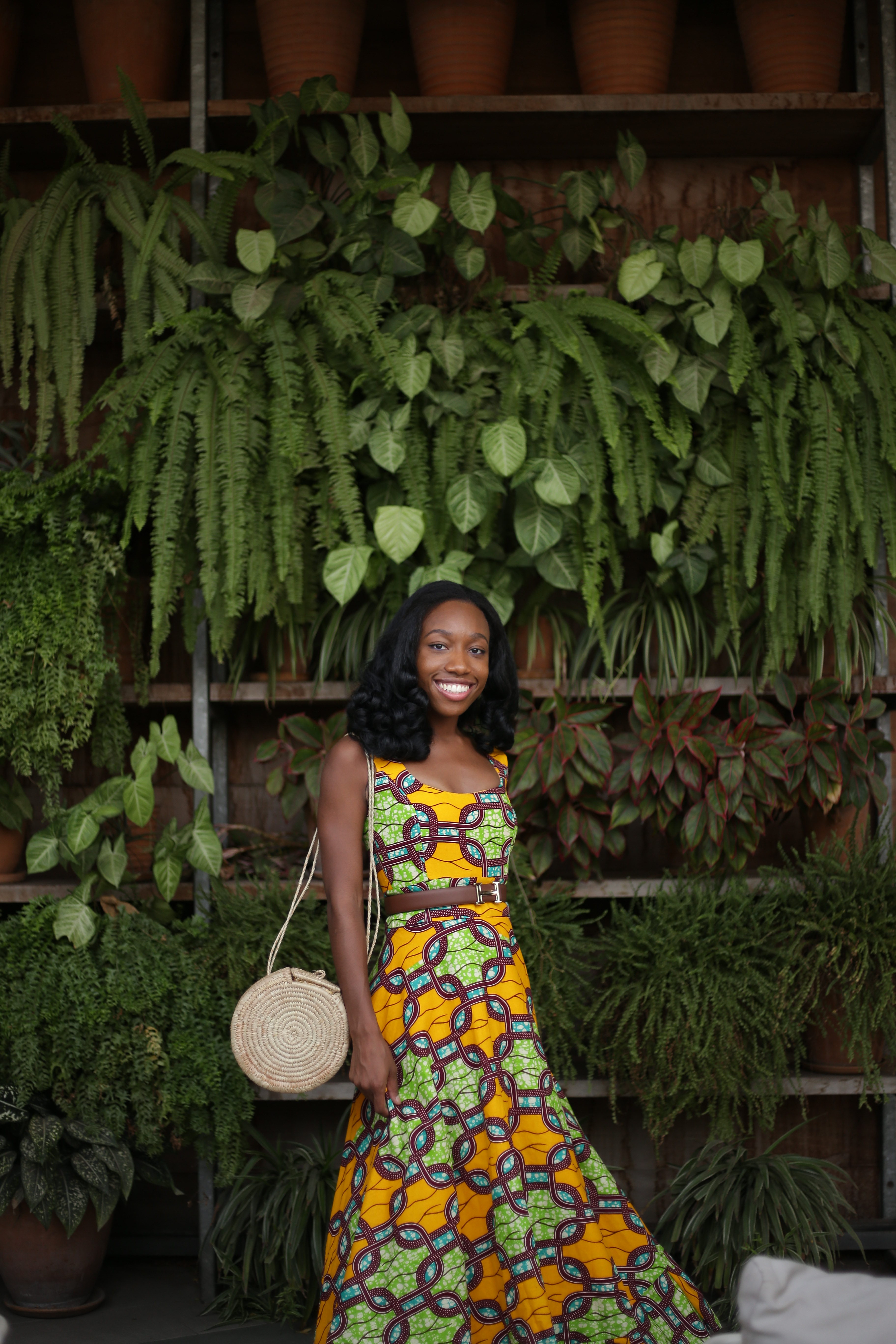
My love for wax print fabric began in 2014 while living in South Africa. I quickly became fascinated with the vibrant beauty in every fabrics’ design. Even after returning home to the United States, I remained interested in the complexity of Ankara patterns and shapes. I made Pinterest boards of my favorite wax print looks and started shopping for Ankara online. After my initial introduction to wax print, I thought I knew a few things about “African fashion”.
Boy, was I wrong.
Moving to Ghana last year made me realize just how little I knew about the diverse and colorful world of Ankara fabrics. Fabric shopping at Makola Market in the heart of Accra has become a favorite past time, not simply because I love fashion, but for the vast quality of fabrics to choose from.
Throughout Ghana, wax print garments are part and parcel of the fashion culture. On any given day you can see women walking and selling goods on the street all while slaying in head-to-toe wax print cloth.
Until this past year, I honestly had no idea how HUGE the industry was.
According to The Guardian, Ankara print fabrics generate… “an annual sales volume of 2.1 billion yards at an average production cost of $2.6 billion and retail value of $4 billion.”
The current market generates an incredible amount of capital for both producers and merchants. With this in mind, I knew there was far more to the story of wax print cloth than I initially assumed.
When most people think of “African fabrics” they use it as a blanket term, without realizing the culture and specifics of Ankara fabrics. A perfect example of my own ignorance on the topic was when I traveled to Kenya for the first time in 2016.
I was so excited to see wax prints in the same way that I had first experienced them in South Africa. Yet, wax print fabrics were not nearly as pervasive in East Africa as I assumed they would be. European clothing culture seemed much more dominant in the region in a way that I didn’t expect.
Having lived in Ghana now for a little over a year, I’ve come to realize that West Africa is in many ways the mecca of wax print fabrics. Though you can find wax print fashion in other regions of the continent, West Africa, in particular, has developed a unique clothing culture surrounding Ankara that doesn’t exist in other parts of the continent. According to The Guardian, “West Africa accounts for 65 percent of the market with Nigeria accounting for 38 percent of total demand for African print fabric.”
How it All Began
The method for dying wax print fabrics actually originated in Indonesia. Finding out this information was so fascinating to me! Something that’s now closely tied with West African culture originated all the way in South East Asia. The Javanese method called, “Batik” was used to create fabrics like the one pictured below. This method is unique because the pattern is printed all the way through so both sides are evenly dyed.

So how did Batik fabric make its way to Africa?
The short answer is colonization.
Dutch colonists who took over Indonesia were incredibly impressed with the fabrics. Once they returned to the Netherlands they replicated the printing method with the help of their more advanced block printing machines, roller printing, and eventually whole factories that used machines like the perrotine. At the time, industrialization was making waves in Europe. Printing machines could quickly churn out products which made Europe an epicenter for the mass production of textiles. By using this technology to mimic the way Indonesians printed designs, they were able to make fabrics more efficiently and at a cheaper cost……(ugh, colonialization sucks).
When the Dutch tried to sell their “imitation” fabrics back in Indonesia, the locals weren’t having it. Of course, they wanted the real thing. BUT, West African mercenaries and slaves, whom the Dutch had enlisted to boost their armies in Indonesia, became familiar with the fabrics. Even though the Indonesians were unimpressed (and imitation fabrics eventually banned in the Dutch Indies), the Dutch and Scottish found a successful trading market upon returning to their ports on the West African coast. So in the late 1880s, these fabrics slowly weaved themselves into the local West African cultures….(no pun intended lol).
Even though the fabrics were largely consumed by African markets, fabrics were primarily manufactured in Europe before the 1960s. Up until World War I the wax print market was widely dominated by the Haarlem Cotton Company in the Netherlands. When their company went under, the modern-day fabric giant, Vlisco, bought them out. (The outfit I’m wearing in this blog post is a Vlisco fabric).
The Modern Era of Wax Print
Vlisco is largely responsible for the creation and widespread distribution of textiles in the post-war era. Their iconic designs have evolved as African women have personalized designs and attached deeper meaning to the fabrics. A perfect example is what we now know as the ‘dashiki’. This print, originally known as the “Angelina” was designed by Toon van de Manakker of Vlisco. It was modeled after a 19th-century Ethiopian woman’s tunic and was released around the same time the popular Ghanian band, “The Sweet Talks” released their song, ‘Angelina‘.
During the Black Power Movement and the rise of Pan Africanism in the 1960s and 70s, the dashiki was popularized across the diaspora as a symbol of black pride. Even today we’ve witnessed a resurgence of the dashiki with the Black Lives Matter Movement and with elements of black culture becoming more mainstream.

Many other wax print designs carry cultural significance and hidden meanings depending on the context. (More on that in part 2 of this series!)
After many African countries gained independence, the mass production of Ankara textiles on the continent became popular with factories stretching across West Africa. Vlisco housed brands like Uniwax, GTP, and Woodin that are produced in Ghana and the Ivory Coast.
Current Industry Challenges
With continued technological developments and the ever-shifting dominance in world trade and manufacturing, the wax print industry is facing many challenges. Textiles do not require the same amount of physical labor due to modern mechanization. In turn, the industry doesn’t need to provide as many jobs as it once did in the 1900s.
Besides the use of more machines in production, the second major challenge has been the near take-over of the Chinese in a once African-dominated market. Lots of impersonation (aka ‘dupe’) wax-print fabrics are out on the market.
Is this the natural order of things as the world becomes more globalized, or is this a tragedy for African markets?
How will wax print fashion evolve in Africa with these challenges in mind?
While I don’t have all of the answers, this leaves lots of questions for designers and stylists who seek to promote fashion that reflects elements of African culture and the history of the continent.

****** What do you love about wax print? What’s your favorite brand? Comment below and let me know your thoughts on these questions and more! If posts like these interest you, don’t forget to subscribe to the blog.

Joy Balkcom
September 16, 2019 at 7:33 pm (5 years ago)I love wax print fabrics. I have a couple of tops and skirts, and I’m hoping to do like a friend of mine did and use some nice fabrics as pillows for my couch. How can you tell if the material is authentic and not Made in China?!
kaylaah@umich.edu
September 18, 2019 at 3:41 pm (5 years ago)Hey! One of the easiest ways to tell is based on the feel of the fabric itself. Authentic cloth tends to be really dense and sturdy-feeling. You can also tell by the barcodes that are on the fabric label if you buy the fabric in yards. If you’re buying a ready-made dress or item it will be harder to tell unless you deconstruct the garment. These are some great youtube videos on the topic!
https://www.youtube.com/watch?v=EwrWv-osOB0
https://www.youtube.com/watch?v=Ggsc8wf_Mss
https://www.youtube.com/watch?v=0_j9p4evRlA
Stella Enara Joseph
October 10, 2019 at 5:45 pm (5 years ago)Ankara happens to be by best stock in my wardrobe. Since I’m gifted in crafting things with Ankara, I use the pieces to create almost any and everything you can think of, coasters, wall decorations, throw pillow cases, etc. And guess what?!! No two pieces of my artwork are the same.
Now this is the best part of it.. On my 50th birthday in July this year, my friends surprised me with 14 pieces of Ankara fabrics of diverse grades, shades and colours because they know my love for Ankara. I was overwhelmed! I love the Ethics look it gives me!
kaylaah@umich.edu
November 11, 2019 at 1:02 pm (4 years ago)That’s so amazing! I can’t get over how beautiful the fabrics are as well! It’s such a blessing you were gifted with so many choices!
Upendo
October 11, 2019 at 5:29 pm (5 years ago)I’m Tanzanian and I have to make a few corrections here. You said you went to Kenya which explain your views about less African centric dressing culture, each East African country is very different from the next. In Tanzania we have Khanga fabrics and why you call Ankara we call Kitenge, we use Khanga everyday from shower to headwear to quick skirt to carrying a baby. I am from Dar-Es-Salaam and our culture is mixture of Arabic and African, we have people who cover themselves with Khanga to go to work daily. We make dresses or just outfits and don’t forget those tingatinga carvings also dressed in Khanga. Maasai people wear their own colorful fabrics daily, they don’t know how to wear anything else and we rock beads all over. I suggest you visit Tanzania especially Dar-Es-Salaam, Zanzibar, Pemba, Arusha and Mwanza. There’s a different East Africa waiting for you, of course don’t get me started with the food: hint, it’s better than Ghana too:)
kaylaah@umich.edu
November 11, 2019 at 1:06 pm (4 years ago)Thanks for sharing this great info! You have me very curious now to learn more about Khanga. I definitely hope to visit Tanzania some day in the near future. I visit Kenya at least once a year so one of these days I’ll make it happen. lol I LOVE East African food. I would have to agree it’s better than Ghanian food….(shhhhhh don’t tell my Ghanian friends).
Norma
October 13, 2019 at 9:24 pm (5 years ago)Hi I’m selling Ankara fabrics, will you please recommend which country can I buy genuine fabrics and how? Im in SA.
kaylaah@umich.edu
November 11, 2019 at 1:15 pm (4 years ago)I know that both Ghana and Nigeria have large quantities of fabrics in terms of supply. Maybe you can reach out the the fabric manufacturers of the brands that you are interest in supplying to ensure the fabrics are genuine. They should be able to direct you further. I’ve never sold fabrics myself so I’m not a complete expert for sales and logistics lol.
Karen Brantley
October 16, 2019 at 3:03 pm (5 years ago)Are wax prints good for making apparell to wear ?
kaylaah@umich.edu
November 11, 2019 at 1:08 pm (4 years ago)Yes the fabrics are great for all kinds of outfits and apparel! They’re also ideal for pillows and even curtains as well! The possibilities are endless.